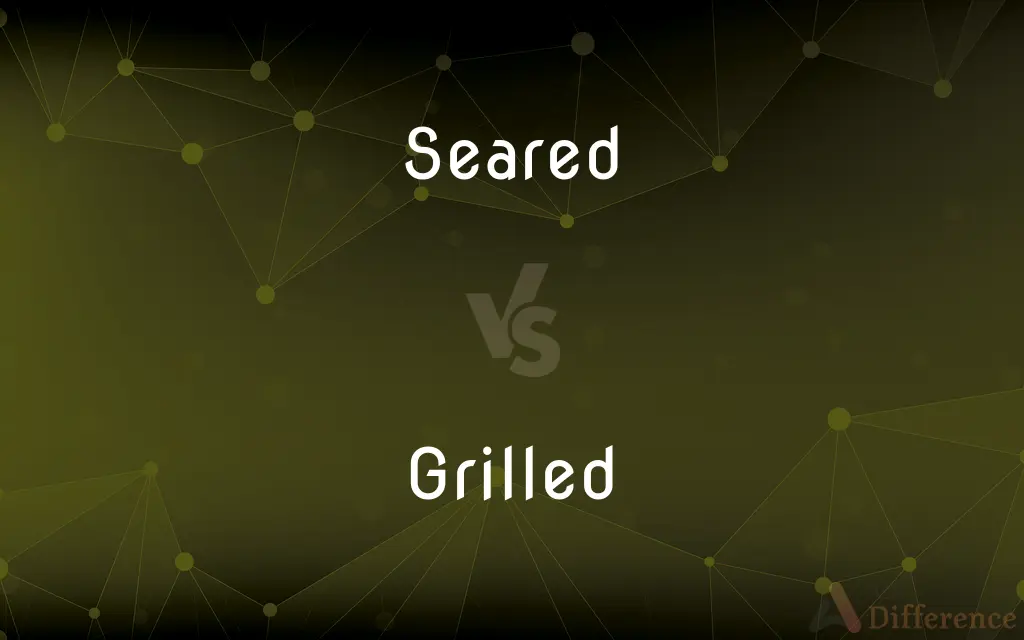Seared vs. Grilled — What's the Difference?
By Urooj Arif & Maham Liaqat — Updated on March 31, 2024
Seared involves cooking the surface of food at a high temperature until a brown crust forms, focusing on flavor development. Grilled refers to cooking food over direct heat, often on a grate, which adds distinctive grill marks and a smoky flavor.

Difference Between Seared and Grilled
Table of Contents
ADVERTISEMENT
Key Differences
Seared foods are quickly cooked at high temperatures, typically in a pan, to create a caramelized, brown crust that enhances flavor through the Maillard reaction, without necessarily cooking the item through. Grilled foods, on the other hand, are cooked over direct heat, usually from below, and often involve longer cooking times to fully cook the item through, imparting a smoky flavor and grill marks as visual and flavor cues.
While searing is primarily used to start the cooking process or add a flavorful crust, with the interior often remaining less cooked, grilling is a more comprehensive cooking method that can fully cook the food, with the heat source directly impacting the food’s flavor and texture through smoke and char.
Searing is typically done in a pan with a small amount of oil to prevent sticking and ensure even crust formation, concentrating on creating a rich, complex flavor surface. Grilling requires preheating the grill to achieve the right temperature for cooking, with the food often prepared with marinades or rubs to complement the natural smoky flavors.
The tools for searing include heavy skillets or pans, preferably those that can withstand high temperatures, like cast iron. Grilling, however, utilizes outdoor or indoor grills, with variations such as gas, charcoal, or electric, each adding a unique flavor profile to the food.
In terms of technique, searing is about quick, high-heat cooking, focusing on the surface of the food. Grilling involves managing the heat source, cooking times, and sometimes smoke, to achieve the desired doneness and flavor, often with the food being flipped to cook evenly on both sides.
ADVERTISEMENT
Comparison Chart
Cooking Method
High-temperature pan cooking
Cooking over direct heat, often on a grate
Flavor Profile
Caramelized crust, rich flavor
Smoky flavor with grill marks
Heat Source
High heat from a stove
Direct heat from charcoal, gas, or electric grill
Typical Use
To start cooking or add flavor crust
To fully cook and flavor food
Tools
Heavy skillet or pan
Grill (outdoor or indoor), grill tools
Compare with Definitions
Seared
Requires a hot pan and little oil.
He seared the fish, developing a flavorful crust.
Grilled
Involves preheating the grill and flipping food.
He expertly grilled vegetables, turning them for even char.
Seared
Cooking at high heat to create a brown crust.
The chef seared the steak for a minute on each side.
Grilled
To cook through while adding flavor.
Grilling the corn added a unique taste.
Seared
Typically uses a cast iron skillet or pan.
A heavy pan is best for searing meat evenly.
Grilled
Adds a smoky taste and grill marks.
The grilled chicken had a delightful smoky flavor.
Seared
Results in a caramelized surface.
The seared scallops had a rich, golden crust.
Grilled
Cooking food over direct heat, with smoke.
They grilled burgers at the barbecue.
Seared
Often to initiate cooking or add texture.
She seared the pork before roasting it.
Grilled
Requires a grill, which can be gas or charcoal.
Using a charcoal grill adds a distinctive flavor.
Seared
To char, scorch, or burn the surface of.
Grilled
To broil on a gridiron.
Seared
To brown (meat) quickly using very high heat.
Grilled
To torture or afflict as if by broiling.
Seared
Simple past tense and past participle of sear
Grilled
(Informal) To question relentlessly; cross-examine.
Seared
Blackened by heat; scorched; burned
Grilled
To mark or emboss with a gridiron.
Seared
Scorched; cauterized; hence, figuratively, insensible; not susceptible to moral influences.
A seared conscience and a remorseless heart.
Grilled
A cooking surface of parallel metal bars; a gridiron.
Seared
Having the surface burned quickly with intense heat;
The seared meat is then covered with hot liquid for braising
Grilled
Food cooked by broiling or grilling.
Grilled
An informal restaurant or a room in a restaurant where grilled foods are served. Also called grillroom.
Grilled
A series of marks grilled or embossed on a surface.
Grilled
Variant of grille.
Grilled
Simple past tense and past participle of grill
The meat was grilled as this was considered the healthier option.
She grilled him over his whereabouts the previous night.
Grilled
Cooked on a grill.
Grilled
As if cooked on a grill.
After a day in the sun, he looked more grilled than his hamburger.
Grilled
Fitted with a grille.
Grilled
Cooked by radiant heat (as over a grill)
Grilled
Cooked over an outdoor grill
Common Curiosities
What foods are best for grilling?
A wide variety of foods, including meats, vegetables, and fruits, are suited to grilling, which adds unique flavors and textures.
What is the main difference between searing and grilling?
Searing quickly browns food at high heat for flavor, while grilling cooks food over direct heat, adding a smoky flavor and grill marks.
Can you sear food on a grill?
Yes, you can sear food on a grill by using high heat for a short time before moving it to a cooler part of the grill to finish cooking.
What foods are best for searing?
Foods that benefit from a quick, high-heat method to develop flavor, like steaks, scallops, and tuna, are ideal for searing.
Does searing "seal in" juices?
This is a common myth. Searing adds flavor but doesn't actually seal in juices. Proper resting after cooking helps retain moisture.
What's the benefit of using a cast iron skillet for searing?
Cast iron provides even heat distribution and retains high heat well, making it ideal for creating a consistent, caramelized crust.
How do you achieve the best grill marks?
Preheat the grill, place the food on the grill grate, and don’t move it until the marks form, then rotate or flip for even cooking.
Can you use a grill pan for both searing and grilling?
Yes, a grill pan can be used on a stovetop to simulate grilling, including searing with grill marks, but it won't impart the same smoky flavor as outdoor grilling.
How do you know when the grill is hot enough?
The grill is ready when you can hold your hand about an inch above the grate for only a few seconds before it feels too hot.
Is searing necessary before grilling?
Not always, but searing before grilling can enhance flavor and texture, especially for thicker cuts of meat.
Share Your Discovery

Previous Comparison
Waivered vs. Wavered
Next Comparison
Glyphosate vs. ParaquatAuthor Spotlight
Written by
Urooj ArifUrooj is a skilled content writer at Ask Difference, known for her exceptional ability to simplify complex topics into engaging and informative content. With a passion for research and a flair for clear, concise writing, she consistently delivers articles that resonate with our diverse audience.
Co-written by
Maham Liaqat














































